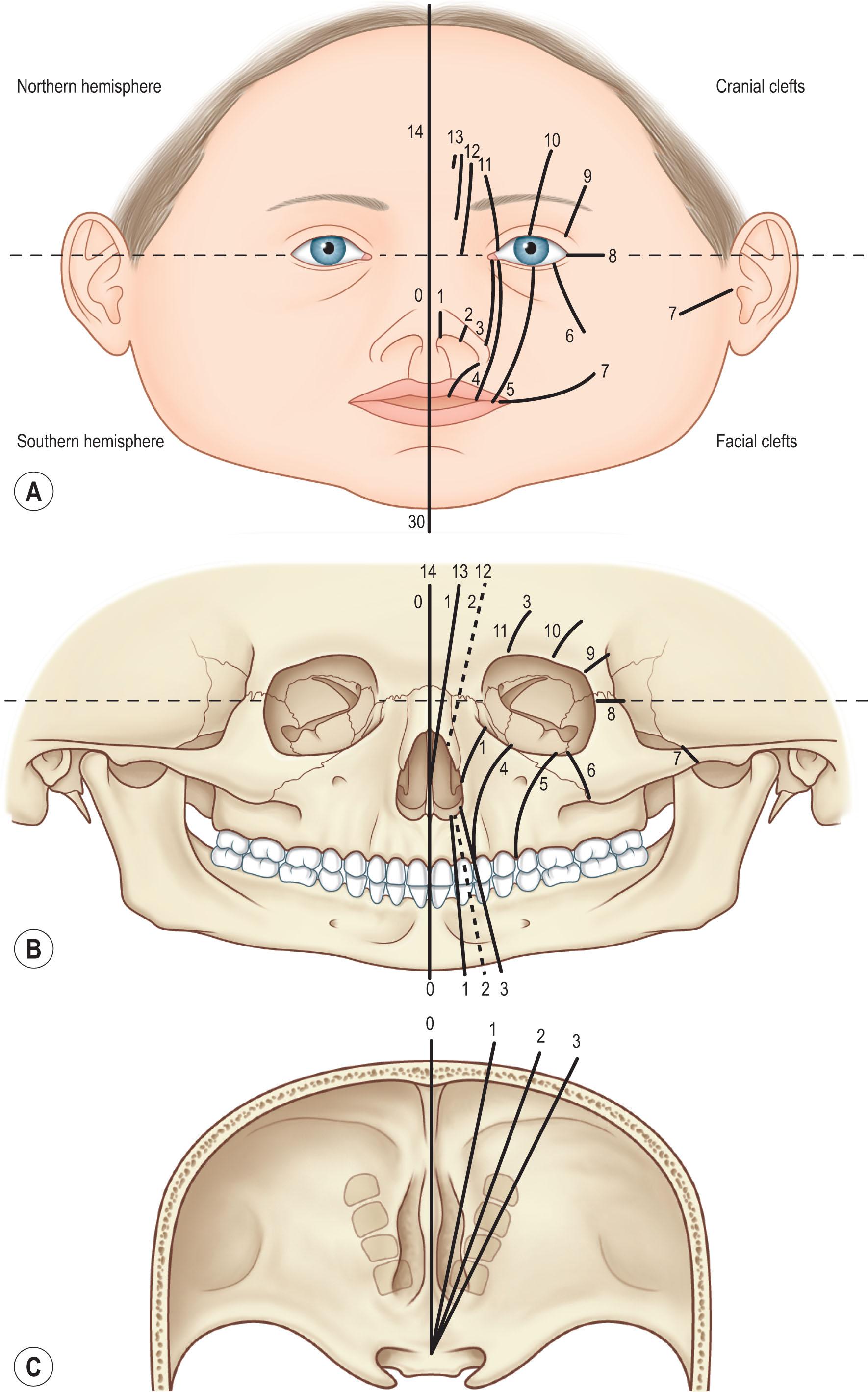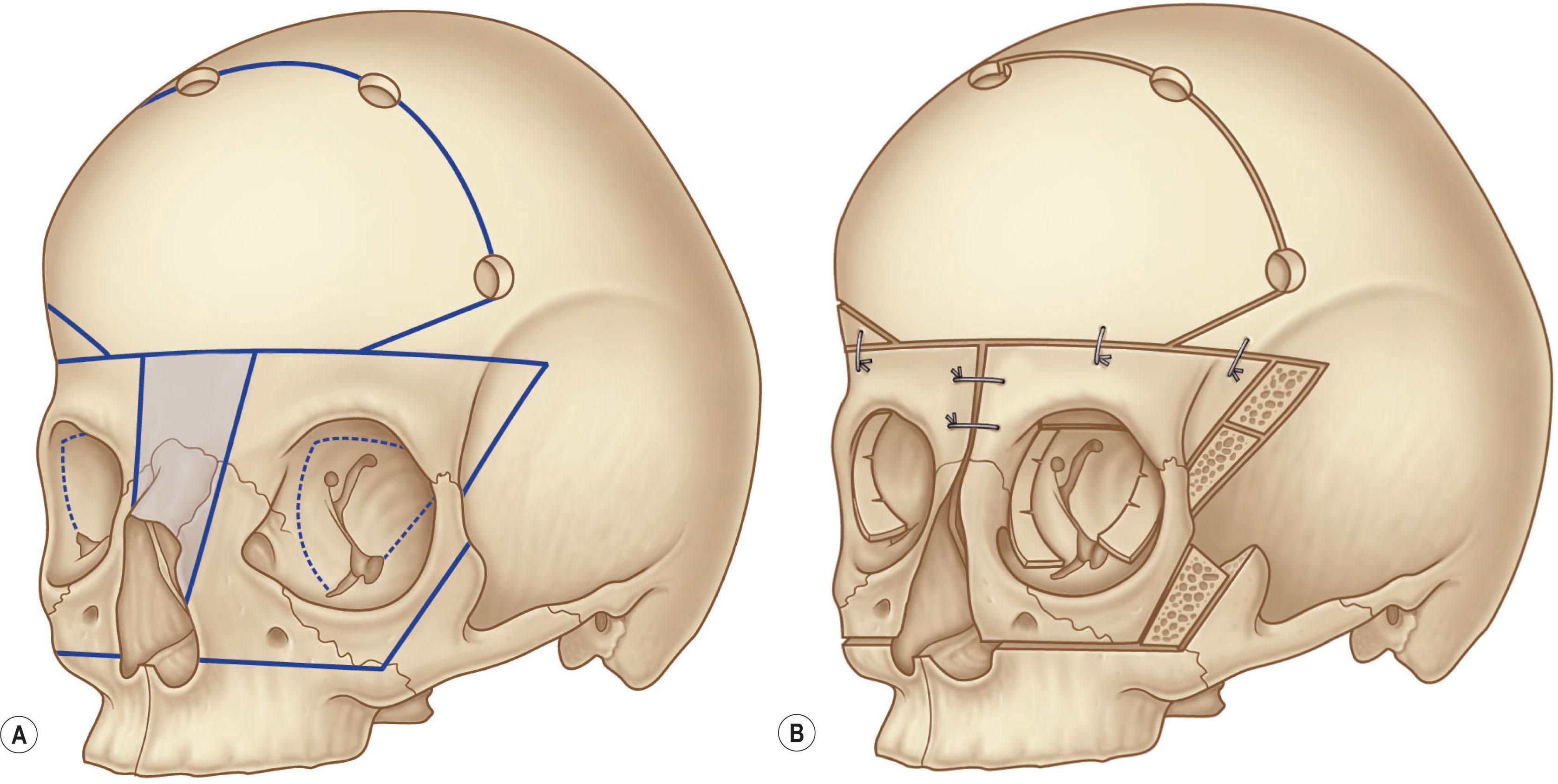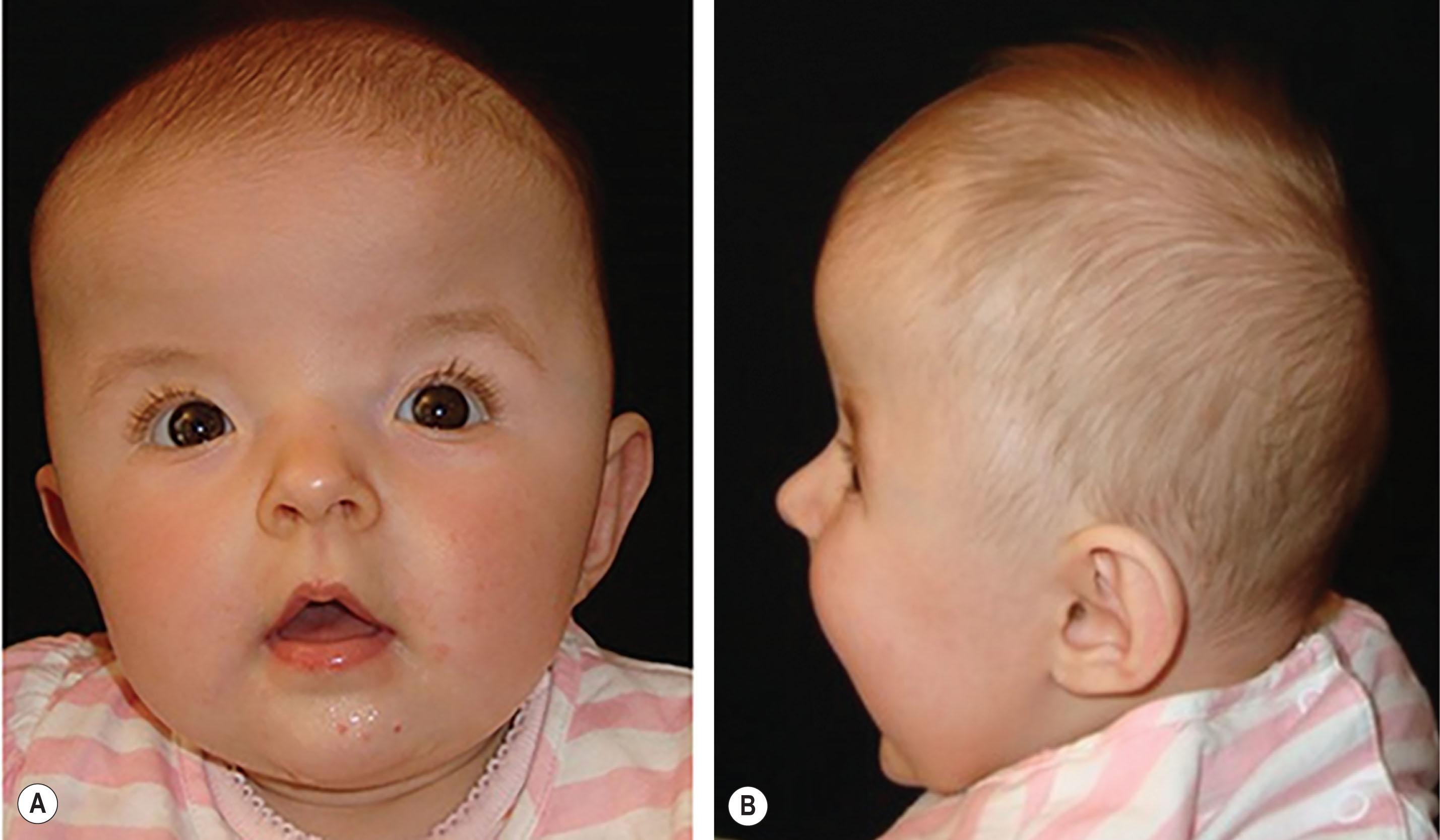Physical Address
304 North Cardinal St.
Dorchester Center, MA 02124
Hypertelorism is not a disease in itself; it is just a symptom which may belong to various conditions.
It is mainly present in facial clefts but may accompany faciocraniosynostosis, where craniosynostosis has to be corrected independently before 1 year of age.
In mild forms such as familial brachycephaly associated with Muenke mutations, it is rarely treated, and the bicoronal synostosis is treated alone.
Surgical treatment of hypertelorism can be undertaken after age 4 and preferably before age 8 (at completion of cerebral growth and before frontal sinus development).
The technique of correction depends upon the degree of interorbital distance and on the occlusion.
According to the degree of interorbital distance, the technique is based on a two-, three-, or four-wall mobilization, through a subcranial or a transcranial approach.
If the occlusion is normal, the osteotomy is a box-shift type; if the occlusion is angulated, a facial bipartition osteotomy and medialization of the two hemifaces are performed.
Rhinoplasty is best performed at the end of growth; it represents one of the most important morphological improvements of the whole therapeutic sequence.
Minor additive procedures contribute to the completion of the result: epicanthus correction, medial and lateral canthopexy, and fat grafting in the temporal region.
Intellectual development in patients with facial clefts is usually good.
![]() Access video content for this chapter online at Elsevier eBooks+
Access video content for this chapter online at Elsevier eBooks+
Craniofacial malformations are disorders that affect both the cranium and the face. In faciocraniosynostoses, the facial maldevelopment is associated with craniosynostosis (premature fusion of one or several sutures). In facial clefts, the major anomaly affects the face and is occasionally associated with a cranial problem. Hypertelorism is not a disease in itself; rather, it is a symptom or associated finding which accompanies some craniofacial conditions. Hypertelorism is defined by the abnormal increase in the interorbital distance (between the bony orbits). The abnormality may be symmetrical or asymmetrical.
In embryonic development, the development of the face occurs early, between the fourth and eighth weeks of gestation. When one observes that the midportion of the face develops immediately anterior to the forebrain, it is obvious that there is a close relationship between the face and the brain. Lateral to this midline prominence, paired elements appear: the nasal placodes and the maxillary processes. These structures merge in the midline whilst the frontonasal prominence is displaced in a cephalic direction. This prominence narrows to form the bridge and root of the nose. The developing eyes present as optic vesicles “outpouching” from the brain and are initially positioned far laterally. The optic vesicles move closer together as the frontonasal prominence narrows. Simultaneously, the tip of the nose is derived from the paired medial elements, as the paired maxillary and mandibular processes fuse to form the lower part of the face. Clefts of the midline craniofacial structure occur when this delicate sequence of events is disrupted.
If the frontonasal prominence remains in its embryonic position, the optic placodes cannot migrate toward the midline, and this results in orbital hypertelorism, often associated with various anomalies of the forehead and nose. It had been said that “the face predicts the brain”, and the importance of the centrofacial anomaly appears to parallel the forebrain defect. Conversely, interrupted development of the medial prominence may lead to an absence of midline structures with excessive narrowing, such as cyclopia or ethmocephaly. Hypertelorism alone is a mild degree of this sequence at the orbital level.
The associated maxillary anomalies seen with hypertelorism consist mainly of insufficient anterior growth in the upper maxilla, resulting in maxillary retrusion. Since the face is physiologically underdeveloped in infancy, facial anomalies may be more apparent later in childhood when facial growth is completed.
There is little known of the genetics of craniofacial malformations, likely due to the limited number of cases. As major facial clefts are rare, most of our knowledge of the pathogenesis of these malformations is based on studies of the formation of cleft lip and palate. Nevertheless, the role of heredity is obvious in the more frequent clefts of the lip, palate, and the lateral aspects of the orbit.
Radiation, infection, and maternal metabolic imbalances, which can be involved in cleft lip, have not been reported to be responsible for craniofacial malformations. Drugs and chemicals such as tretinoin, thalidomide, corticosteroids, and even aspirin are known to be responsible for malformations; and, while facial development occurs early in pregnancy, mothers may ingest various drugs while unaware of being pregnant. Causal environmental and hereditary factors probably play varying epigenetic roles in the formation of particular malformations.
Various systems of classification have been proposed for craniofacial clefts; two of them are of special value when assessing craniofacial anomalies. These are the “median facial clefts” and the Tessier classification, an orbitocentric cleft classification.
Hypertelorism is not dangerous in itself and, until the surgical breakthroughs of Tessier in the late 1960s, one would observe untreated adult patients, mainly with facial clefts, in whom hypertelorism was the main visible feature. Those patients with hypertelorism usually had normal mental development and few complaints besides a desire for aesthetic improvement. The intracranial approach has been the main advance in the treatment making it effective to correct the deformity. There is little doubt that the creativity of Tessier and the boldness of his neurosurgeon colleague Gérard Guyot, both working at Hôpital Foch in the suburbs of Paris, made this a reality. When Tessier asked Guyot if it was conceivable to medialize the orbits through an intracranial approach, Guyot answered with the now famous “Why not?” and, from that starting point, they made it possible. The first patient with hypertelorism was treated in a staged surgical strategy, with the initial procedure closing the superior extent of the nasal fossa with a dermal skin graft and sacrifice of the olfactory nerve. Six months later in a secondary procedure, medialization of the orbits was performed (1967).
Later many authors have refined the initial technique, but the frontal craniotomy remains the key access to the orbits. Except in the major forms, the procedure is carried out in a single stage, and there is no longer sacrifice of the olfactory bundle, which is respected with a more anterior bony cut on the midline. A refinement introduced by Marchac allows a slightly modified design of the forehead which allows conservation of two lateral bony spurs which make the frontal bandeau osteotomy unnecessary.
Median facial clefts can be divided into two categories: those presenting with a deficiency of tissue and missing parts and those without lack of tissue but presenting with a widening malformation.
Midline tissue deficiency malformations are almost always linked with a forebrain deficiency. The term “arrhinencephaly” has been used, but holoprosencephaly, a name proposed by De Myer et al ., better reflects the lack of median tissues. On the basis of this brain–facial linkage, and including some concepts of Cohen and associates, the holoprosencephalic malformations present with hypotelorism, as opposed to hypertelorism.
In contrast with the previous group, near-normal to excess tissue midline disorders do not have a high correlation between the facial anomalies and the underlying brain. The deformities can range from a notch in the upper lip and a widened nose to the most severe form of midline cleft. The term “frontonasal dysplasia”, suggested by Sedano et al . for this group of anomalies, is used widely, especially amongst geneticists. Frontonasal dysplasia and holoprosencephaly are therefore at opposite ends in this system of classification of midline anomalies.
This classification does not take into account all the asymmetrical and paramedian anomalies. For easier definition and treatment implications, the authors use the Tessier classification, which is based on surgical experience.
In the Tessier classification, the orbit is the reference landmark, common to both the cranium and the face. The clefts, numbered from 0 to 14, rotate around the orbit and follow constant lines through the skeleton and soft tissues ( Fig. 23.1 ). Clefts can be mostly cranial if they run upward from the eyelid (7–14) or mostly facial if they run downward from the palpebral fissure (0–6). They are craniofacial if the upper and lower pathways are connected.

The following combinations can be clinically observed: 0 and 14, 1 and 13, 2 and 12, 3 and 11, and 4 and 10. This concept of additive facial and cranial clefts equaling 14 is helpful when examining the patient and often allows identification of malformation along its entire length, above and below the orbit. The severity of the cleft is highly variable and can range from a slight soft-tissue indentation to a complete open cleft. The soft-tissue and skeletal clefts are, on the whole, superimposable. However, a detailed description of the soft-tissue defect, in relation to the skeletal cleft, is more reliable, because the skeletal landmarks are more consistent. The Tessier classification defines the 0–14 cleft as a midline widening, present in frontonasal dysplasia.
Unilateral and bilateral forms of clefting are found in various combinations, mainly asymmetrical when bilateral. Three-dimensional computed tomography has greatly facilitated diagnosis, whilst magnetic resonance imaging explores the brain, looking for an associated malformation. Stereolithographic models, constructed from computedtomography images, are also available and may be useful for diagnosis and surgical planning as these malformations are uncommon and rarely identical.
Some isolated facial clefts, such as those affecting the lateral aspect of the face in Treacher Collins syndrome (bilateral 6, 7, and 8 clefts), do not present any surgical interest for the neurosurgeon. The central and paramedial clefts affecting the face and cranium are of neurosurgical interest due to the need of transcranial access for surgical correction.
Hypertelorism is not the main feature of faciocraniosynostosis, and is variable in its presentation. When mild, it is frequently left untreated; however, when more noticeable, it can be addressed through a separate surgical step. Depending on the dental occlusion, and particularly the horizontal position of the upper maxillary arch, the treatment of hypertelorism will vary between an orbital shift and a facial bipartition. The timing of treatment is variable according to the pathology; however, in the authors’ experience, skull expansion for craniosynostosis treatment should precede hypertelorism correction.
Described by Crouzon in 1912, this syndrome involves only the face and cranium and is not associated with other anomalies elsewhere on the limbs or trunk. The fundamental dysmorphology is an underdeveloped midface presenting with exorbitism secondary to insufficient depth of the orbits, hypoplasia of the malar bones, and a class III malocclusion. Hypertelorism may be present but is usually mild. The nose is short. Brachycephaly is usually present; however, scaphocephaly, plagiocephaly, or even a cloverleaf skull may be present. With an extended classification, the association of facial retrusion and craniosynostosis might be named as a related Crouzon anomaly. Commonly, the diagnosis of Crouzon syndrome is difficult to make during the first year of life, even if brachycephaly is obvious. It is often difficult to know whether the midface will be affected, even on radiological examination. Midface retrusion and exorbitism appear later in life. In some cases, however, the diagnosis is evident at birth.
Severe maxillary retrusion may produce airway obstruction with mandatory mouth breathing. There is a great variability of expression, and both severe and mild forms can be observed in the same family.
The strategy of treatment of faciocraniosynostosis is either two-stage (fronto-orbital first, then facial advancement later) or a single-stage frontofacial monobloc advancement, preferably with distraction. Whenever present, the hypertelorism might be corrected around 4–5 years of age, usually with an orbital shift ( Fig. 23.2 ), because in Crouzon disease, the maxillary arch is normal (at least in the horizontal dimension).

Described by Pfeiffer in 1964, this syndromic entity is an association of faciocraniosynostosis and anomalies of the hands and feet. The brachycephaly induced by bicoronal synostosis is often asymmetrical and is associated with midface retrusion secondary to maxillary hypoplasia. Hypertelorism is often present in this syndrome. The thumbs and great toes are broad with a varus deviation and may be associated with soft-tissue syndactylies, the latter being difficult to diagnose early in life. Some severe forms exist, with marked perinatal frontofacial retrusion resulting in visual and respiratory problems. This condition is sometimes associated with a cloverleaf skull.
The strategy of treatment is similar to that for Crouzon syndrome, but Pfeiffer syndrome is often more severe than Crouzon, with a higher tendency to relapse after surgical advancement.
First described by Apert in 1906, this syndrome is easy to recognize because of the associated syndactyly of the hands and feet. The severity of syndactyly is scored according to Cohen and Kreiborg. Type 1 is syndactyly of the central three digits, type 2 is syndactyly of digits 2–5, and type 3 is syndactyly of all five digits.
The craniofacial involvement is always marked at birth, in contrast with that in Crouzon disease, with brachycephaly (sometimes asymmetrical) associated with facial retrusion. Both coronal sutures are fused, although some rare cases present with unilateral coronal synostosis or without any synostoses (four cases without synostoses in our series). The hypertelorism and the anterior open bite add to the distinction from Crouzon disease. In fact, the maxillary alveolar arch is higher than the posterior part of the palate. Another main difference with Crouzon is the frequent sagittal dehiscence of the sutural system with the anterior fontanelle frequently remaining wide open during the first year of life; this contributes to the abnormally wide forehead and face in this syndrome. Associated abnormalities of the central nervous system are more frequent than in other syndromic craniosynostoses. The exception is Chiari-like malformations, which are common in Crouzon disease but, due to premature fusions of the lambdoid sutures, are uncommon in Apert syndrome. Because of these patients’ divergent frontal plane, bipartition procedures are more adapted to correct Apert-associated hypertelorism. Nevertheless, skull expansion (either anterior or posterior) is performed first, usually before 1 year of age to address the craniosynostotic skull.
In the group of craniofacial dysplasias (see discussion of median facial clefts with frontonasal dysplasia, below), some cases present with a bicoronal craniosynostosis, including a subgroup called craniofrontonasal dysplasia. There is a brachycephaly, often marked, associated with the facial anomalies of frontonasal dysplasia, which include hypertelorism, broad nasal bridge, and bifid nose; soft-tissue syndactyly may also be present.
Craniofrontonasal dysplasia is far more common in females than in males, paradoxically with its X-linked inheritance because of aberrant cell segregation in the craniofacial primordium. In the authors’ series, 36% of cases were familial, and 91% of patients were females. Unaffected males carrying the mutation may transmit to their daughters.
In the bilateral craniosynostosis associated with Muenke mutations, there is often a mild enlargement of the orbital distance. Usually there is no aesthetic request of correction since it integrates in the brachycephalic phenotype ( Fig. 23.3 ).

The choice between orbital shift procedures and bipartition is mainly linked to a series of factors:
The maxillary arch: if the maxillary arch is narrow and inverted with the incisors being higher than the molars, bipartition is the operation of choice because it widens the maxilla and improves the angle of the upper dentition. On the other hand, if the maxillary arch and occlusion are normal, it is preferable to avoid a pterygomaxillary disjunction.
The axis of the orbits: if the axis is normal, a horizontal mobilization is satisfactory; if the orbits are laterally and downwardly oblique, bipartition is required.
The nasal fossae: if they are narrow, bipartition and medialization of the upper face improve the airways by enlarging the lower part of the face.
Extent of the hypertelorism: bipartition is the operation of choice in the most severe cases, whereas orbital shift is indicated for more limited displacements.
The bipartition procedure can also be used to get access to a lesion of the cranial base. Some midline clefts are associated with an encephalocele of the ethmoidosphenoidal area. After midline splitting, easy access to the encephalocele can be obtained.
In the situation of a patient with only one seeing eye, the indication for the procedure should be carefully considered and, although less efficient, a unilateral correction of the non-seeing orbit can be discussed.
Become a Clinical Tree membership for Full access and enjoy Unlimited articles
If you are a member. Log in here